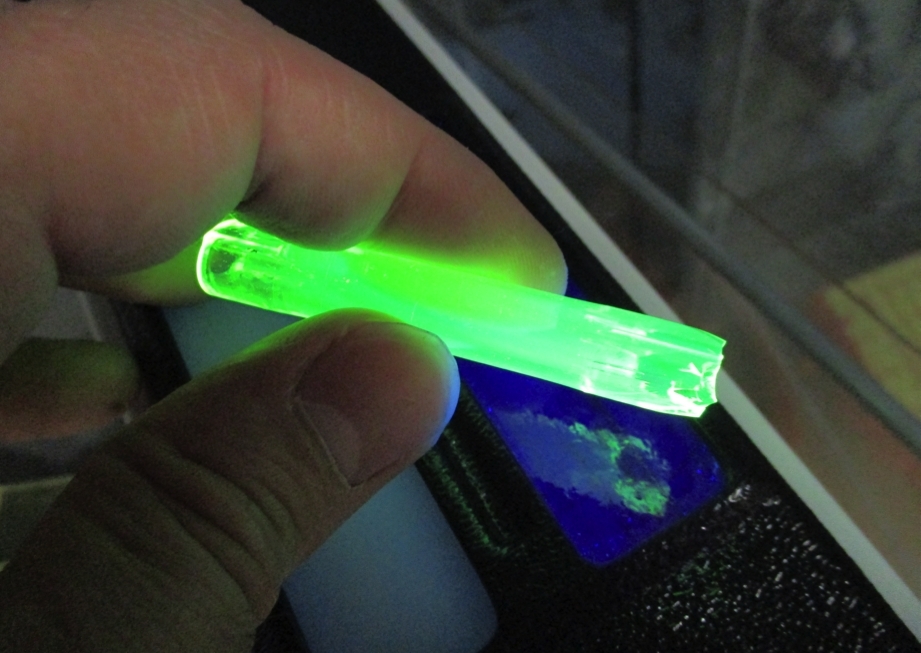

Glass preform irradiated with blue laser (emission of green light due to electron transitions in Tb3+). A fiber preform is a piece of optical glass (researchers’ photo)
Brazilian scientists have developed an innovation that can be used in sensors to monitor brain function with even greater sensitivity than existing devices.
Brazilian scientists have developed an innovation that can be used in sensors to monitor brain function with even greater sensitivity than existing devices.

Glass preform irradiated with blue laser (emission of green light due to electron transitions in Tb3+). A fiber preform is a piece of optical glass (researchers’ photo)
By José Tadeu Arantes | Agência FAPESP – A magneto-optical fiber that may be able to detect extremely weak magnetic fields has been developed at the Special Glass Laboratory (LaVie) attached to São Paulo State University’s Institute of Chemistry (IQ-UNESP) in Araraquara, Brazil. An article about it is published in the journal Scientific Reports.
“Our fiber is as sensitive as the magneto-optical crystals used in the interferometer at the LIGO experiment, which first detected gravitational waves, and has two additional advantages: it’s much cheaper, and it can be produced with various lengths, potentially reaching hundreds of meters, making it very convenient for certain kinds of sensor,” chemist Marcelo Nalin, a professor at IQ-UNESP and principal investigator for the study, told Agência FAPESP.
The LaVie lab is attached to the Center for Research, Technology and Education in Vitreous Materials (CeRTEV), one of the Research, Innovation and Dissemination Centers (RIDCs) funded by FAPESP. The study was supported by FAPESP via a research grant awarded to CeRTEV under the RIDC program, and a postdoctoral fellowship and research internship abroad scholarship awarded to Douglas Faza Franco, first author of the article. Researchers affiliated with the Federal University of São Carlos (UFSCar), University of São Paulo (USP), University of Brasília (UnB), and Laval University (ULAVAL) in Canada also participated.
The fiber is made of glass comprising several oxides, especially germanium dioxide (GeO2) and boron trioxide (B2O3), with a high concentration of terbium ions (Tb3+), and can be used to detect tiny variations in a magnetic field. The possible applications include brain activity sensing based on changes in electric current with higher sensitivity than existing detectors, volcanic activity forecasting based on the monitoring of magnetic fluctuations in magma, and submarine detection.
“Morphological analysis of the sample with the highest concentration of terbium ions confirmed that they were homogeneously distributed without forming nanoclusters. In addition, all samples displayed excellent thermal stability against crystallization, which is critical for optical fibers,” Nalin said.
The key to the innovation is the Faraday effect, discovered in the mid-nineteenth century by English physicist and chemist Michael Faraday (1791-1867). Convinced that light was an electromagnetic phenomenon, Faraday sought evidence that its behavior could be affected by electric and magnetic forces. The experiments he had the means to perform at the time were not sensitive enough to detect the effect of an electric field, which occurred later, but after several attempts, he succeeded in proving experimentally the effect of a magnetic field on a polarized light beam as it passed through a block of heavy glass.
“What happens when polarized light passes through glass in the presence of a magnetic field is that its polarization plane rotates around the direction of propagation, and the angle of rotation is directly proportional to the intensity of the magnetic field and the distance traveled by the light,” Nalin explained.
The mathematical equation that describes the phenomenon is simple and can be written as follows: θ = V.B.L, where θ (the Greek letter theta) is the angle of rotation of the plane of polarization of the light beam; V is a constant (known as the Verdet constant) that depends on the material of which the glass is made; B is the intensity of the magnetic field; and L is the distance traveled by the light while under the effect of the magnetic field.
“Looking at this equation, it’s easy to see the advantage of using optical fiber, because the distance [L] traveled by light inside the fiber is very great and even a very small change in the magnetic field [B], such as those seen in brain waves, for example, can produce a measurable rotation [θ] in the polarization of the light. By measuring the angle of rotation, it’s possible to estimate the value of the magnetic field,” Nalin said.
The move from laboratory experiments to the production of devices for practical use evidently requires a great deal of technological development, but the researchers can envisage use of the innovation in a range of applications, from volcano sensing with hundreds of meters of underground fiber to brain sensing with a few centimeters coiled inside a helmet.
The Scientific Reports article “Magneto-optical borogermanate glasses and fibers containing Tb3+” is at: www.nature.com/articles/s41598-021-89375-1.
Republish
The Agency FAPESP licenses news via Creative Commons (CC-BY-NC-ND) so that they can be republished free of charge and in a simple way by other digital or printed vehicles. Agência FAPESP must be credited as the source of the content being republished and the name of the reporter (if any) must be attributed. Using the HMTL button below allows compliance with these rules, detailed in Digital Republishing Policy FAPESP.





